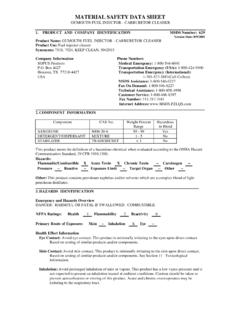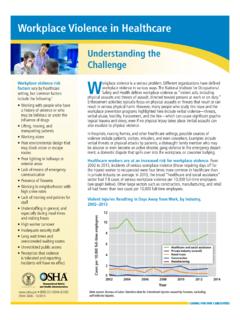Transcription of Material Safety Data Sheet - acsrefrigerant.com
1 Material Safety Data SheetGenetron 141bMSDS Number:GTRN-0015 Page 1 of 8 Current Issue Date: January, PRODUCT AND COMPANY IDENTIFICATIONPRODUCT NAME:Genetron 141bOTHER/GENERIC NAMES:HCFC-141bPRODUCT USE:Blowing agent for insulating foam. See Section 15 for Regulatory InformationMANUFACTURER:Honeywell101 Columbia RoadBox 1053 Morristown, New Jersey 07962-1053 FOR MORE INFORMATION CALL:IN CASE OF EMERGENCY CALL:(Monday-Friday, 8:00am-5:00pm)1-800-707-4555(24 Hours/Day, 7 Days/Week)1-800-707-4555 orChemtrec ON INGREDIENTSINGREDIENT NAMECAS NUMBERWEIGHT %Dichlorofluoroethane1717-00-6100 Trace impurities and additional Material names not listed above may also appear in Section 15 toward the end of the materials may be listed for local "Right-To-Know" compliance and for other IDENTIFICATIONEMERGENCY OVERVIEW: Colorless, volatile liquid with ethereal and faint sweetish odor.
2 Non-flammablematerial. Overexposure may cause dizziness and loss of concentration. At higher levels, CNS depression andcardiac arrhythmia may result from exposure. Vapors displace air and can cause asphyxiation in confinedspaces. At high temperatures (>250 C), decomposition products may include Hydrochloric Acid (HCl),Hydrofluoric Acid (HF) and carbonyl halides, such as HEALTH HAZARDSSKIN:Prolonged and/or repeated contact with this solvent can cause irritation of the skin (defatting of skin).EYES:Irritant. Liquid contact will irritate and may cause :Overexposure to vapor may cause dizziness, loss of concentration and irritation.
3 With high exposurelevels, effects can include central nervous system (CNS) depression (intoxication) and cardiacarrhythmia. Product vapors displace air and can cause suffocation especially in a confined :Discomfort due to volatility would be expected. Some of the inhalation effects could be EFFECTS:None Safety DATA SHEETG enetron 141bMSDS Number:GTRN-0015 Page 2 of 8 Current Issue Date: January, 2000 Ingredients found on one of the osha designated carcinogen lists are listed NAMENTP STATUSIARC STATUSOSHA LIST*No ingredients listed in this section* AID MEASURESSKIN:Promptly flush skin with water until all chemical is removed.
4 Remove clothing contaminated with liquid and washbefore :Immediately flush eyes with large amounts of water for at least 15 minutes, lifting eyelids occasionally to facilitateirrigation. Get medical :Immediately remove patient to fresh air. If breathing has stopped, give artificial respiration. Useoxygen as required, provided a qualified operator is available. DO NOT give epinephrine (adrenaline). Getmedical attention :DO NOT induce vomiting unless instructed to do so by a physician. DO NOT give stimulants. Get medicalattention TO PHYSICIAN:Because of possible disturbances of cardiac rhythm, catecholamine drugs such as epinephrine,should be used with special caution and only in situations of emergency life of overexposure should be directed at the control of symptoms and the FIGHTING MEASURESFLAMMABLE PROPERTIESFLASH POINT:NoneFLASH POINT METHOD:ASTM D-1310-67 and ASTM D-56-82 AUTOIGNITION TEMPERATURE:550 CUPPER FLAME LIMIT (volume % in air) FLAME LIMIT (volume % in air) flammable limits were determined using ASTM E-681-79.
5 The45 joule spark test showed no flammable limits. The limits shown weredetermined using the fused wire with match ignition PROPAGATION RATE (solids):Not applicableOSHA FLAMMABILITY CLASS:Not applicableEXTINGUISHING MEDIA:Use any standard agent - choose the one most appropriate for type of surrounding fire ( Material itself in not flammable)UNUSUAL FIRE AND EXPLOSION HAZARDS:Product will decompose at temperatures above 250 C. Decomposition products include hydrochloric acid, hydrofluoric acid,and carbonyl halides, such as phosgene. Contact with certain finely divided metals may cause exothermic reaction and/orexplosive combinations.
6 Vapors, when present in the flammable range (listed above), especially in a confined or poorlyventilated space, can be ignited with a flame or high intensity source of Safety DATA SHEETG enetron 141bMSDS Number:GTRN-0015 Page 3 of 8 Current Issue Date: January, 2000 SPECIAL FIRE FIGHTING PRECAUTIONS/INSTRUCTIONS:Firefighters should wear self-contained, NIOSH-approved breathing apparatus for protection against suffocation and possibletoxic decomposition products. Proper eye and skin protection should be provided. Use water spray to keep fire-exposedcontainers cool and to knock down vapors which may result from product RELEASE MEASURESIN CASE OF SPILL OR OTHER RELEASE:(Always wear recommended personal protective equipment.)
7 Immediately evacuate the area and provide maximum ventilation. Try to eliminate all ignition sources. Unprotectedpersonnel should move upwind from spill. Only personnel equipped with proper respiratory and eye/skin protection shouldbe permitted in the area. Dike area to contain the spill. Take precautions as necessary to prevent contamination of groundand surface waters. For large spills, pump solvent into appropriate containers. For small spills, recover or absorb spilledmaterial using an absorbant designed for chemical spills such as Hazsorb pillows.
8 Place used absorbants into closed DOTapproved containers for disposal. After all visible traces have been removed, thoroughly wet vacuum the area. DO NOTflush into sewer. If the area of the spill is porous, removal of contaminated earth/surface may be and releases may have to be reported to Federal and/or local authorities. See Section 15 regarding AND STORAGENORMAL HANDLING:(Always wear recommended personal protective equipment.)Genetron 141b boils at F, hence contents may be under pressure. Exercise caution when opening container.
9 Ifcontainers have been stored in direct sunlight or heated above the boiling point of the solvent, the container should be cooledto below the boiling point before Opening PrcedureTo open container, follow these procedures to avoid loss and contamination of the Tear off protective cap over large bung Carefully remove the 3/4 inch plug from the center of the large bung. DO NOT puncture the inner Insert convenient length 3/4 inch nipple fitted with a closed valve. As nipple is inserted, the inner seal is broken and containeris ready to unload through RECOMMENDATIONS:Keep container closed when not in use.
10 DO NOT store in open, unlabeled or mislabeled containers. Store in a cool, well-ventilated area of low fire risk. Protect container and its fittings from physical damage. Storage in subsurface locationsshould be avoided. Close valve tightly and repalce bung after use and when empty. If container temperature exceeds boilingpoint, cool the container before CONTROLS/PERSONAL PROTECTIONENGINEERING CONTROLS:Use local exhaust at filling zones and where leakage is probable. Use mechanical (general) ventilation for storage areas. Allventilation should be designed in accordance with osha standard (29 CFR ).









